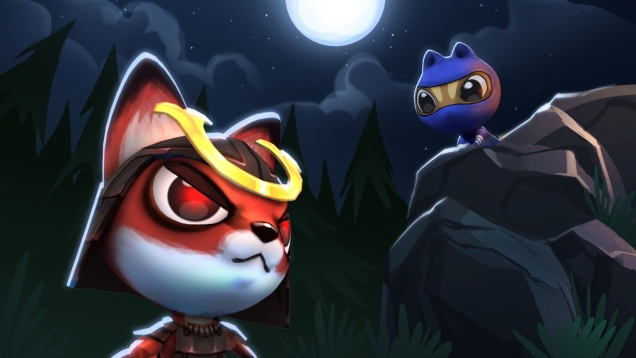Review: Nutjitsu: Reforged
Community
Nutjitsu: Reforged
Wahoo Studios/NinjaBee Games
Reviewed on: PS4
Also Available on: Xbox One, PC
Street: 07.21
The small, homegrown talents at NinjaBee Games in Orem, Utah, have created many unique, addictive and successful games since 2004. They’ve created turn-based strategy games and puzzle platformers, but throughout their 11 years, their bread and butter has been city-builders. They released their first console game alongside the launch of the Xbox 360 back in 2005 with Outpost Kaloki X, where you’re tasked with building a space station and maintaining its profitability. In 2008, they released what is arguably their most popular and successful game, A Kingdom for Keflings. You, as your avatar on the Xbox 360, play as a god who assists and delegates tasks to tiny gnome people, lending your hand in turning their diminutive town into a thriving kingdom. The original was so popular on XBLA that it deserved a sequel, A World of Kefllings. Built upon the originals’ concept, they added two more nations to the formula, tying them together with a more relevant story. Since the 2011 release of A World of Keflings and a Wii U port two years later, they started work on Nutjitsu for the PC, Xbox One and PS4.
Nutjitsu is a complete departure for NinjaBee and their previously aforementioned genres. This maze runner puts you in control of the mysterious ninja squirrel (squirrel ninja?) Rizu. He must take back his (never mentioned) clan’s sacred acorns from the fox samurai clan, Kitsune. They are made up of just three different enemy types: the persistent Hunter, the savvy Dasher and the poisonous Trapper. It feels and looks like an adorable homage to Pac-Man, but instead of eating dots and dodging ghosts, you’re either trying to survive for as long as possible, collecting as many acorns as you can, or playing through missions with varying objectives. These Ninja Missions range from collecting any number of acorns or specific colors; snatching and delivering said acorns to a neutral location; stealing back secret scrolls; or controlling an annex-style neutral zone. No matter the game type — the more you collect, the more populated the enemies become, making objectives more difficult to achieve.
The most glaring aspect isn’t the UI, with its non-descriptive and symbolic menu options; it’s the obvious mobile-game aesthetic and design. Over the years, NinjaBee’s focus has primarily been console games, so it’s strange to see that they’ve designed Nutjitsu for mobile platforms. While a controller makes sense to move around the beautifully drawn levels with precision, the same could have easily been achieved with a touch-screen-joystick in the lower left hand side of the screen. The same can be said for the power-ups mapped to the four face buttons. All of them are displayed on the left hand side, and could very easily have been switched to the right for easy accessibility. Depending on the situation, pushing X will activate the smoke bomb, allowing you to slip away undetected. Pushing square will activate the freeze bomb, stopping the pursuant samurai in their tracks. For distraction and luring purposes, a well-timed press of the circle button will send out your shadow clone, dutifully drawing enemies away. Finally, if you find yourself frustrated with a pursuer, or you’re a pyromaniac, you can ignite enemies with a flame shield — killing them instantly.
In theory, Nutjitsu has a great formula to be a fun, interesting and challenging maze-runner, but in practice it never comes to fruition. After cranking up the difficulty for both Ninja Missions and Survival, the game began to shine, but still fell short of capturing the classic fun of the genre. Despite including trophies, un-lockable maps, finite upgrade options, and leader-board supremacy, none of these gave me any reason to keep playing Nutjitsu. The immensely talented team at NinjaBee have somewhat stumbled with this title. While their craftsmanship is still present, it doesn’t showcase their true abilities as game designers. They gambled with a new idea, went outside of their comfort zone and missed the mark. Studios need to try new things, and it’s reassuring to see that they’re willing to do so. Whatever they have cooking up next will most definitely be worth everyone’s attention—unfortunately, it’s not Nutjitsu.


